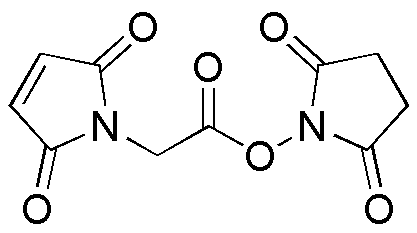a-Maleimidoacetic acid-NHS is widely utilized in research focused on:
- Bioconjugation: This compound is frequently used to attach biomolecules, such as proteins or peptides, to surfaces or other molecules, enhancing the development of targeted drug delivery systems.
- Diagnostics: It plays a crucial role in the creation of diagnostic tools, such as biosensors, by facilitating the immobilization of antibodies or antigens, improving the sensitivity and specificity of tests.
- Vaccine Development: The compound is instrumental in vaccine formulation, allowing for the conjugation of antigens to carriers, which can enhance immune responses and provide better protection against diseases.
- Polymer Chemistry: In the field of materials science, it is used to modify polymers, resulting in materials with improved properties, such as increased biocompatibility for medical applications.
- Protein Engineering: Researchers utilize this compound for site-specific labeling of proteins, which is essential for studying protein interactions and functions in various biological processes.
General Information
Properties
Safety and Regulations
Applications
a-Maleimidoacetic acid-NHS is widely utilized in research focused on:
- Bioconjugation: This compound is frequently used to attach biomolecules, such as proteins or peptides, to surfaces or other molecules, enhancing the development of targeted drug delivery systems.
- Diagnostics: It plays a crucial role in the creation of diagnostic tools, such as biosensors, by facilitating the immobilization of antibodies or antigens, improving the sensitivity and specificity of tests.
- Vaccine Development: The compound is instrumental in vaccine formulation, allowing for the conjugation of antigens to carriers, which can enhance immune responses and provide better protection against diseases.
- Polymer Chemistry: In the field of materials science, it is used to modify polymers, resulting in materials with improved properties, such as increased biocompatibility for medical applications.
- Protein Engineering: Researchers utilize this compound for site-specific labeling of proteins, which is essential for studying protein interactions and functions in various biological processes.
Documents
Safety Data Sheets (SDS)
The SDS provides comprehensive safety information on handling, storage, and disposal of the product.
Product Specification (PS)
The PS provides a comprehensive breakdown of the product’s properties, including chemical composition, physical state, purity, and storage requirements. It also details acceptable quality ranges and the product's intended applications.
Certificates of Analysis (COA)
Search for Certificates of Analysis (COA) by entering the products Lot Number. Lot and Batch Numbers can be found on a product’s label following the words ‘Lot’ or ‘Batch’.
*Catalog Number
*Lot Number
Certificates Of Origin (COO)
This COO confirms the country where the product was manufactured, and also details the materials and components used in it and whether it is derived from natural, synthetic, or other specific sources. This certificate may be required for customs, trade, and regulatory compliance.
*Catalog Number
*Lot Number
Safety Data Sheets (SDS)
The SDS provides comprehensive safety information on handling, storage, and disposal of the product.
DownloadProduct Specification (PS)
The PS provides a comprehensive breakdown of the product’s properties, including chemical composition, physical state, purity, and storage requirements. It also details acceptable quality ranges and the product's intended applications.
DownloadCertificates of Analysis (COA)
Search for Certificates of Analysis (COA) by entering the products Lot Number. Lot and Batch Numbers can be found on a product’s label following the words ‘Lot’ or ‘Batch’.
*Catalog Number
*Lot Number
Certificates Of Origin (COO)
This COO confirms the country where the product was manufactured, and also details the materials and components used in it and whether it is derived from natural, synthetic, or other specific sources. This certificate may be required for customs, trade, and regulatory compliance.


